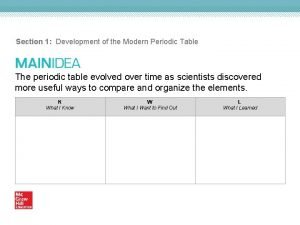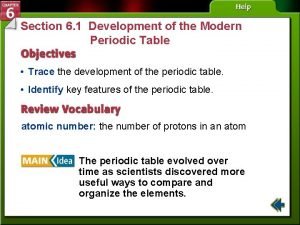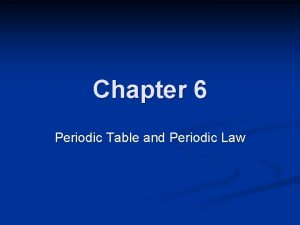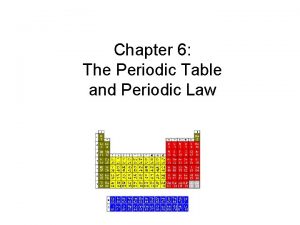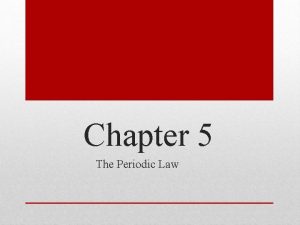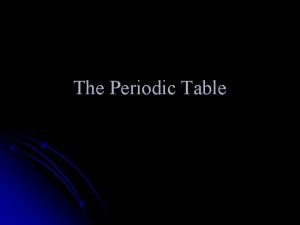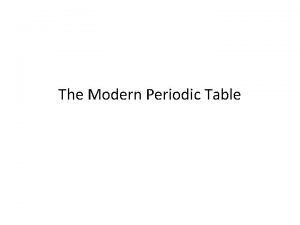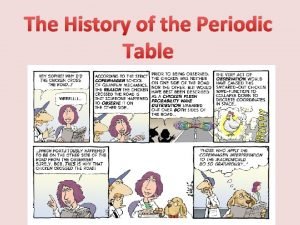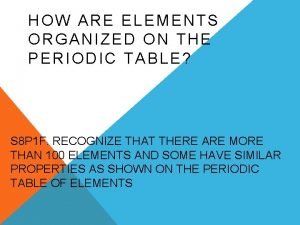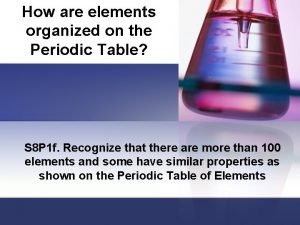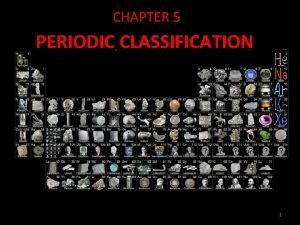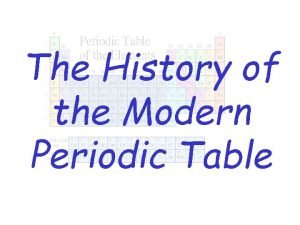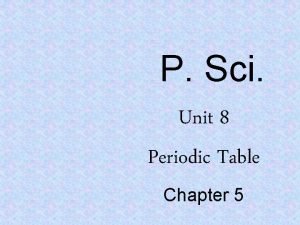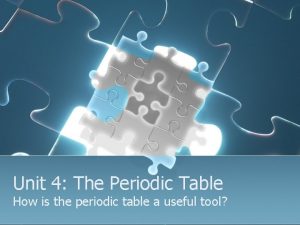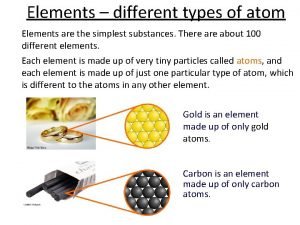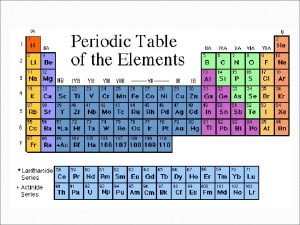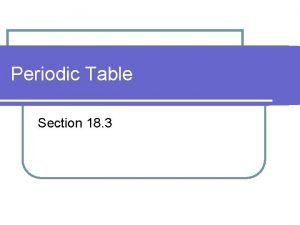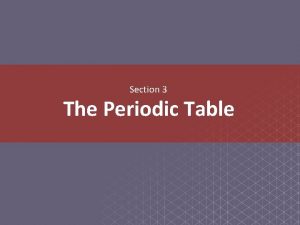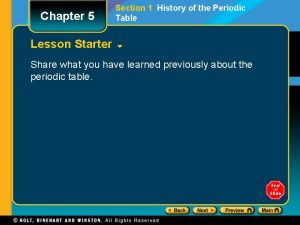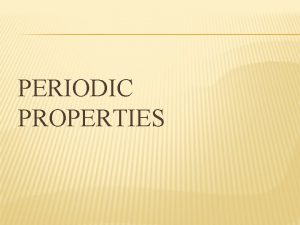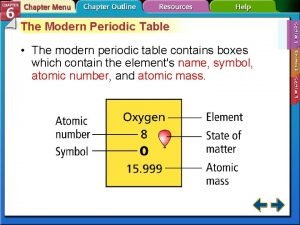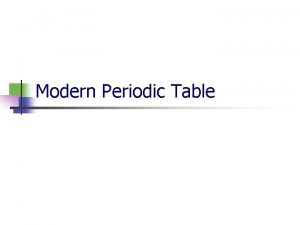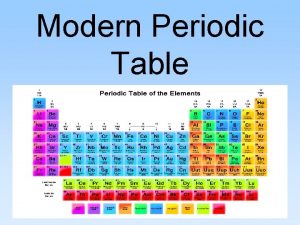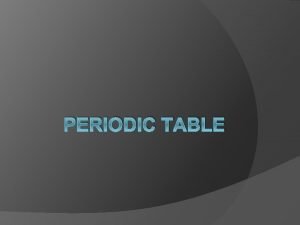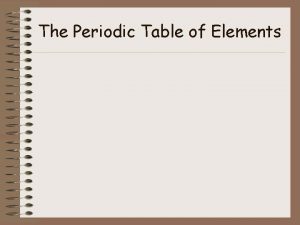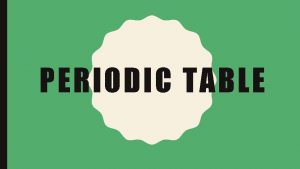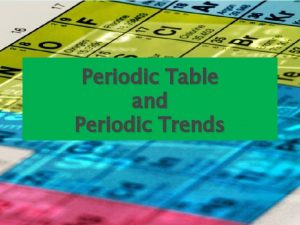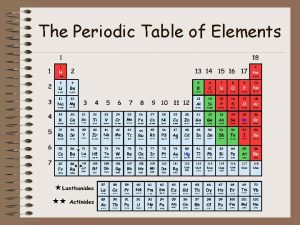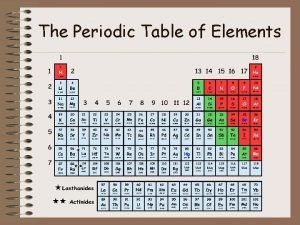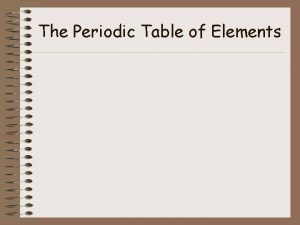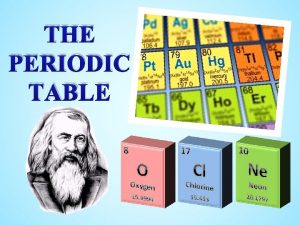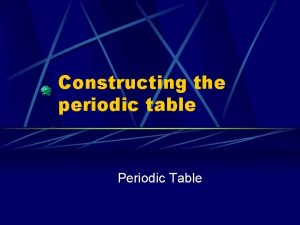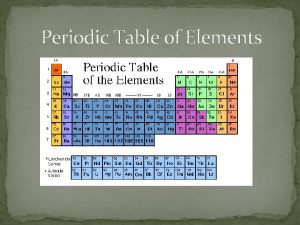Section 6 1 Development of the Modern Periodic

































- Slides: 33

Section 6. 1 Development of the Modern Periodic Table • Trace the development of the periodic table. • Identify key features of the periodic table. atomic number: the number of protons in an atom The periodic table evolved over time as scientists discovered more useful ways to compare and organize the elements.

Section 6. 1 Development of the Modern Periodic Table (cont. ) periodic law group period representative elements transition elements metal alkali metals alkaline earth metals transition metal inner transition metal lanthanide series actinide series nonmetals halogen noble gas metalloid

Development of the Periodic Table • In the 1700 s, Lavoisier compiled a list of all the known elements of the time.

Development of the Periodic Table (cont. ) • The 1800 s brought large amounts of information and scientists needed a way to organize knowledge about elements. • John Newlands proposed an arrangement where elements were ordered by increasing atomic mass.

Development of the Periodic Table (cont. ) • Newlands noticed when the elements were arranged by increasing atomic mass, their properties repeated every eighth element.

Development of the Periodic Table (cont. ) • Meyer and Mendeleev both demonstrated a connection between atomic mass and elemental properties. • Mendeleev is considered the “father of the periodic table” • Is the table arranged by increasing atomic mass today? ? ?

• Moseley rearranged the table by increasing atomic number, and resulted in a clear periodic pattern. • Periodic repetition of chemical and physical properties of the elements when they are arranged by increasing atomic number is called periodic law.


The Modern Periodic Table • The modern periodic table contains boxes which contain the element's name, symbol, atomic number, and atomic mass.

The Modern Periodic Table (cont. ) • Vertical columns of elements are called ______ • Rows of elements are called _____ • Elements in groups 1, 2, and 13 -18 possess a wide variety of chemical and physical properties and are called the representative elements (or the main group elements). • Elements in groups 3 -12 are known as the transition metals.

The Modern Periodic Table (cont. ) • Elements are classified as metals, non-metals, and metalloids. • Metals are elements that are generally shiny when smooth and clean, solid at room temperature, and good conductors of heat and electricity. • Alkali metals are all the elements in group 1 except hydrogen, and are very reactive. • Alkaline earth metals are in group 2, and are also highly reactive.

The Modern Periodic Table (cont. ) • The transition elements are divided into transition metals and inner transition metals. • The two sets of inner transition metals are called the lanthanide series and actinide series and are located at the bottom of the periodic table in the f block.

The Modern Periodic Table (cont. ) • Non-metals are elements that are generally gases or brittle, dull-looking solids, and poor conductors of heat and electricity. • Group 17 is composed of highly reactive elements called halogens. • Group 18 gases are extremely unreactive and commonly called noble gases.

The Modern Periodic Table (cont. ) • Metalloids have physical and chemical properties of both metals and non-metals, such as silicon and germanium.

Section 6. 2 Classification of the Elements • Explain why elements in the same group have similar properties. • Identify the four blocks of the periodic table based on their electron configuration. valence electron: electron in an atom's outermost orbitals; determines the chemical properties of an atom Elements are organized into different blocks in the periodic table according to their electron configurations.

Organizing the Elements by Electron Configuration • Valence electrons: electrons in the highest principal energy level • All group 1 elements have one valence electron.

Section 6. 3 Periodic Trends • Compare period and group trends of several properties. • Relate period and group trends in atomic radii to electron configuration. principal energy level: the major energy level of an atom ionization energy octet rule electronegativity Trends among elements in the periodic table include their size and their ability to lose or attract electrons

Atomic Radius • Atomic size is a periodic trend influenced by electron configuration. • For metals, atomic radius is half the distance between adjacent nuclei in a crystal of the element.

Atomic Radius (cont. ) • For elements that occur as molecules, the atomic radius is half the distance between nuclei of identical atoms.

Atomic Radius (cont. ) • There is a general decrease in atomic radius from left to right, caused by increasing positive charge in the nucleus. • As an atom gets closer to having a filled energy level, it wants to keep its electrons

Atomic Radius (cont. ) • Atomic radius generally increases as you move down a group. • As you add energy levels, they get further from the nucleus


Ionic Radius • An ion is an atom or bonded group of atoms with a positive or negative charge. • Why would an atom want to gain or lose an electron?

Ionization Energy (cont. ) • The octet rule states that atoms tend to gain, lose or share valence electrons in order to acquire a full set of eight valence electrons. • The octet rule is useful for predicting what types of ions an element is likely to form.

• For example, How many electrons does Oxygen need to get an octet? • What would be the easiest way for Na to get an octet?

Ionization Energy • Ionization energy is defined as the energy required to remove an electron from a gaseous atom. • The energy required to remove the first electron is called the first ionization energy.

Ionization Energy (cont. )

Ionization Energy (cont. ) • Removing the second electron requires more energy, and is called the second ionization energy. • Each successive ionization requires more energy, but it is not a steady increase.

Ionization Energy (cont. ) • The ionization at which the large increase in energy occurs is related to the number of valence electrons. • First ionization energy increases from left to right across a period. • First ionization energy decreases down a group because atomic size increases and less energy is required to remove an electron farther from the nucleus.

Ionization Energy (cont. )

Ionization Energy (cont. ) • The electronegativity of an element indicates its relative ability to attract electrons in a chemical bond. • Electronegativity decreases down a group and increases left to right across a period.

Electronegativity

Reactivity: So what elements are most reactive? - Elements with the Lowest Ionization Energy Bottom, Left - Elements with the Highest Electronegativity Top, Right
 Development of the modern periodic table
Development of the modern periodic table Section 6.1 development of the modern periodic table
Section 6.1 development of the modern periodic table Trends in the periodic table of elements
Trends in the periodic table of elements Chapter 6 the periodic table and periodic law
Chapter 6 the periodic table and periodic law How to find out group and period of an element
How to find out group and period of an element 6 the periodic table
6 the periodic table The periodic table and periodic law chapter 6
The periodic table and periodic law chapter 6 The father of the modern periodic table is
The father of the modern periodic table is Right side of periodic table
Right side of periodic table Difference between mendeleev and modern periodic table
Difference between mendeleev and modern periodic table How are elements organized in the periodic table?
How are elements organized in the periodic table? Describe how the modern periodic table is organized.
Describe how the modern periodic table is organized. Characteristics of modern periodic table
Characteristics of modern periodic table Dobereiner triads
Dobereiner triads Mixed groups on the periodic table
Mixed groups on the periodic table Moseley periodic law
Moseley periodic law Modern periodic tabel
Modern periodic tabel Rows vs columns periodic table
Rows vs columns periodic table Section of the periodic table
Section of the periodic table Section 3 the periodic table
Section 3 the periodic table Section 3 the periodic table
Section 3 the periodic table Chapter 5 section 1 history of the periodic table
Chapter 5 section 1 history of the periodic table Hát kết hợp bộ gõ cơ thể
Hát kết hợp bộ gõ cơ thể Ng-html
Ng-html Bổ thể
Bổ thể Tỉ lệ cơ thể trẻ em
Tỉ lệ cơ thể trẻ em Voi kéo gỗ như thế nào
Voi kéo gỗ như thế nào Glasgow thang điểm
Glasgow thang điểm Bài hát chúa yêu trần thế alleluia
Bài hát chúa yêu trần thế alleluia Môn thể thao bắt đầu bằng từ đua
Môn thể thao bắt đầu bằng từ đua Thế nào là hệ số cao nhất
Thế nào là hệ số cao nhất Các châu lục và đại dương trên thế giới
Các châu lục và đại dương trên thế giới Công của trọng lực
Công của trọng lực Trời xanh đây là của chúng ta thể thơ
Trời xanh đây là của chúng ta thể thơ
